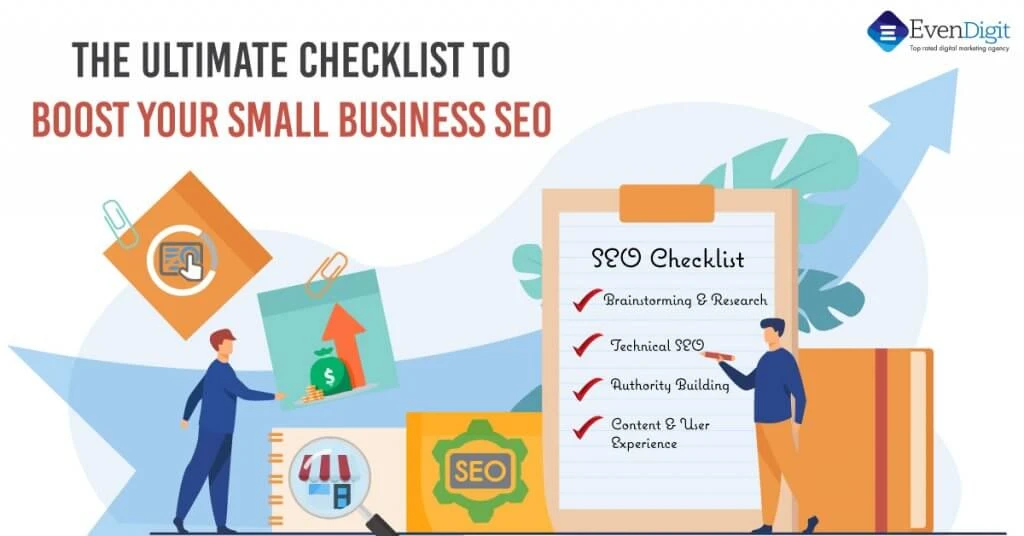SEO maintains your relationship with your customers (website visitors) and GOOGLE! SEO takes time depending on the industry and competition, but it is impactful. If you invest in SEO now, then you can get results in the future. But, for small businesses, everything boils down to questions like – “How can you take SEO with limited resources, money and time?” or “How can small brands compete with big brands?”
The answer lies in this SEO checklist for small business owners. When you will tick off everything on the checklist, you have better chances to attain high SEO rankings, the website traffic and leads.
SEO Checklist for Small Business
Just like a plant cannot grow without water, your small business needs SEO to grow. You need to ensure that you follow activities mentioned in this SEO checklist and no one will be able to stop you from succeeding at making a huge profit. Therefore you will come to know the importance of SEO.
Your SEO checklist comprises of:
- Brainstorming and Research
- Technical SEO
- Content and User Experience
- Authority Building
1. Brainstorming and Research
Brainstorming and Research are the first things to tick off in your small business SEO checklist. An aspiring business owner initially needs to have a clear business idea in his/her mind. If you don’t ideate your business according to your niche, you cannot optimize your website for your target audience.
Here’s how you can do it:
1.1 Understand The Business:
Before taking SEO, you need to assess your current business position in the market. You need to have a good understanding of your audience, competitors and product demand. You should perform an industry analysis that involves factors like geographical area, products and services outlook and target market.
When you have in-depth knowledge about your clients and offerings, you can identify the most profitable SEO activities for your website. An effective competitive research can help you develop a clear and realistic SEO strategy. Thus, understanding your business should be at the top of your SEO checklist.
1.2 Create a Buyer’s Persona
As a business owner, you need to identify all the possible kinds of buyers for your business. You can then analyze their spending behavior, buying decisions and preferred choices. It can also help you to see the scope to expand and grow your business further. Moreover, when you know your audience well, your SEO becomes more relevant and engaging.
1.3 Research Your Chosen Keywords
Proper research about keywords can be beneficial for any kind of business. You need to ensure that the chosen keywords not only correspond to high search volumes, but also your business offerings. Make sure that your keywords match well with your brand and products.
Relevant keywords can drive the right traffic to your website and help you to improve your conversions. You can use keyword tools like Google AdWords to explore useful keywords for your products, services and niche.
1.4 Write Down your Goal
Before taking-off your SEO, you need to narrow down your business goals. According to the niche of your business, you can create different SEO milestones to achieve in periodic intervals. For instance, in the first 6 months, you can aim to rank in the top 50 results of SERPs. And likewise, and so on!
1.5 Compare Yourself with Competition
You can create a list of your competitors and compare your SEO with theirs. You will then be able to understand how your competitors target their audience and rank higher in SERPs. You can start with On-page and then try to match up the off-page just like your competitors.
2. Technical SEO
Technical SEO is another crucial element of the SEO checklist for small business owners. Here you optimize your website for indexing and crawling, which is now a part of the modern search engine working algorithm. It is an important way to ensure that your business meets the technical needs of SERPs.
Here’s how you can do it:
2.1 XML Sitemap Improvements
XML Sitemaps can boost your business SEO. These XML sitemaps help Google and other search engines to find your site’s pages, and improve your SEO. Since Google ranks your website pages along with your site, it becomes important for you to have XML sitemaps.
2.2 Robots.Txt File Optimization
Optimizing Robots.txt file should be a part of your SEO strategy. Robots.txt file tells search engines which web pages to crawl on your website, and which ones not to crawl. This means that you can control the access and indexing of your website. You can improve your SEO and your site’s privacy too.
2.3 Speed Optimization – Desktop and Mobile
Speed Optimization enables to load your website at top speed on mobile and desktop. It is crucial to SEO as even if your website ranks higher in SERPs, your page loading speed can affect your traffic. Majority of the traffic can bounce back due to low page speed and decrease your conversions.
Speed optimization can be quite beneficial to small businesses. Since big brands have large–sized websites, optimizing page speed is easier for businesses with small-sized websites. It creates a clear win-win situation for small businesses.
2.4 Checking For Broken Links
Broken links are a major part of your technical SEO. Because broken links harm both your user experience and SEO. When any page triggers error 404, your visitors spend less time on that page, and search engines rank you lower. Thus, it is better to fix broken links, if any on your site.
2.5 Proper URL Structure
Proper URL Structure is a prerequisite to boost your business SEO. You can always keep a simple, engaging and relevant URL, as per your niche. You can even include keywords in your domain name that will help your brand to rank higher on Google and other search engines.
2.6 Domain-Level Duplicate Content Optimization
Checking for duplicate domain or webpage content is a recommended SEO practice. Make sure they are fully plagiarism-free. If there multiple versions of the same domain, then your website rankings and traffic suffer. When you want your business to be more visible and improve user’s search experience, domain optimization is a must.
2.7 Canonical Tag Optimization
Canonical tags also affect your SEO efforts. Google does not like duplicate content, and these tags prevent problems of duplicate or identical content. For your business, canonical tags optimization directly impacts your rankings and search results.
3. Content and User Experience
Content and User Experience is another vital part of Small business SEO checklist. The perfect blend of relevant content and UX practices scales your SEO. Practicing it in the initial phase of your business is beneficial. A better user experience meets the needs of your visitors, thereby improving your SEO rankings.
Here’s how you can do it:
3.1 Title and Meta Description Tag Optimization
Title and Meta Tags contain a concise description of the content of your webpages. They appear in search results and impact your SEO. With relevant and accurate Meta descriptions, you can increase your CTRs (click-through rates) and site rankings.
3.2 Headings Tags Optimization
Optimizing your content headings and subheadings affect your SEO strategy. Your header tags are essential for both users and Google. Heading optimization indirectly affects your rankings. The more your content is readable and keyword-rich, the more it will be visible on the top pages of Google.
3.3 Mobile Friendliness/Responsiveness
Mobile-friendliness is simply an organized website structure, irrespective of the device being used to access it. You need to ensure that your website appears organized and well-ordered across various screens viz mobiles, tablets, and iPads. When your website is not responsive or mobile-friendly, it harms your conversions. According to research, a conversion happens when a visitor has visited your website 5-8 times.
A non-responsive website fails to impress your visitors. Since mobile visitors have to often perform horizontal as well as vertical scrolling to see the overflowing elements of your site. This restricts them to explore your website content and products, and lower your conversion rate.
3.4 Duplicate Content Optimization
Duplicate content influences your SEO negatively. When you want to rank higher, ensure that your content is not duplicate or identical. Google recognizes and filters out the websites with duplicate content, which results in lower website rankings. So, review your webpages continually.
3.5 Page Content Optimization
On-Page Content Optimization also matters for your SEO practices. From optimizing page URL to image content, your business can grow tremendously with on-page SEO activities. Your content is more likely to appear on search results, thereby improving your rankings and traffic.
4. Authority Building
Authority Building is one of the key pillars of your SEO, and also a vital part of small business SEO checklist. Being a part of off-page SEO, Link building can establish the authority of your local business. You can improve your search engine visibility and business authority in your niche.
Here’s how you can do it:
4.1 Optimize Google My Business Listing
Setting up and optimizing your business listing can help your business greatly. You can build and verify your business’s details on “Google My Business” account. It is one of the useful local SEO strategies for your brand, especially when you are trying to increase your reach.
4.2 Get Positive Reviews
Even a single positive review matters a lot to any business. Positive customer reviews are quite helpful in convincing your website visitors into successful conversions. It can help to build trust and brand credibility among your customers.
Positive reviews are more crucial to small businesses since they have to compete with big brands. Genuine and positive customer reviews can help you to build your customer base even quicker than usual.
4.3 Add Schema Markup
Schema Markup is a new practice in SEO, but you can utilize it to grow your business in today’s time. Schema not just represent what does your content says, but also what does it mean. The search engines can understand the vocabulary and structure of your website, resulting in better site rankings.
4.4 Get Local Listings & Improve the Authority
Listing your business in local listings like Just Dial, Yell, etc. is an effective local SEO practice. When you want your local business to appear in relevant searches and market your brand, local listings help you a lot. You can build your business’s authority within your community and niche.
4.5 Add Trust Badges and Clientele
Including Trust badges and your Clientele base on your website is a useful SEO tactic. When you publish your clients’ logos and their testimonials or trust badges, you somehow convey your excellence, trustworthiness to your potential customers.
Trust Badges and Clientele are a contributing factor to SEO rankings and conversion rate. For example, if you have an eCommerce store, then you can add trust badges on the payment checkout page to convince your users that the process is secure.
Summary
No small business happens to grow overnight. To build your small brand, you should first focus on your SEO and users. The above SEO checklist can help you to make your SEO work faster. Whether you are a budding entrepreneur or a Startup owner who strives to be no. #1 on Google and SERPs, our Small business SEO checklist can help you generate great results. For any help in initiating or establishing a strong SEO for your small-sized business, you can hire our experts to witness rapid growth!
EvenDigit
EvenDigit is an award-winning Digital Marketing agency, a brand owned by Softude (formerly Systematix Infotech) – A CMMI Level 5 Company. Softude creates leading-edge digital transformation solutions to help domain-leading businesses and innovative startups deliver to excel.
We are a team of 70+ enthusiastic millennials who are experienced, result-driven, and hard-wired digital marketers, and that collectively makes us EvenDigit. Read More






